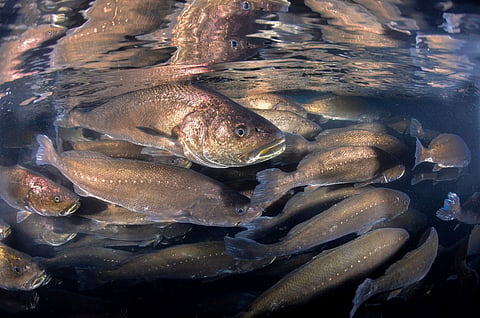

FONDEPES is developing commercially important marine fish farming in Peru through the Morro Sama Aquaculture Center betting for species such as corvina.
Photo: Adobe Stock.
Through the National Fisheries Development Fund (FONDEPES), Peru's Ministry of Production (Produce) delivered 2,275 corvina fingerlings to the Association of Non-boat Artisanal Fishermen and Protectors of the Marine Environment of Puerto de Ilo (APANEMPAM), at the Morro Sama Aquaculture Center in the Tacna region. The initiative aims to promote corvina farming and the diversification of marine aquaculture in Peru.
To support this diversification, FONDEPES is developing commercially important marine fish farming in Peru precisely through the Morro Sama Aquaculture Center. In addition to corvina (Cilus gilberti) - also known as meagre -, sole (Paralichthys adpersus) and white seabream (Anisotremusscapularis) are also farmed.
The head of FONDEPES, Katia Novoa Sánchez, indicated that this delivery is part of the provision of 20,000 corvina fingerlings foreseen within the specific agreement signed with APANEMPAM.
"The purpose of the joint work with APANEMPAM is to develop the experimental farming of corvina in floating cages in the marine concession zone of the association, and in this way evaluate the farming parameters of this species, and the new system of cages in the sea; which allows the productive scaling up of corvina farming in floating cages," she commented.
Delivery of corvina fingerlings at the Morro Sama Aquaculture Center.
Photo: FONDEPES.
The specimens were transported to Ilo and planted in a system of corvina culture tanks installed on land, which will later be transferred to sea cages for the evaluation of sea farming. Professional personnel from the Morro Sama Aquaculture Center and technical personnel from APANEMPAM participated in the transportation process.
Speaking to local radio station Radio Americana after the delivery, Alfredo Maquera, the fisheries engineer in charge of the APANEMPAM project, said that the availability of corvina seed is precisely one of the bottlenecks currently limiting its commercial farming in Peru.
"We are currently building our broodstock," he said. "We have adult corvina, we hope that this year we can have at least one spawning, but, with more certainty, by the year 2025 we will already have spawning. From there we are going to start generating our own fry, and by 2026 we will probably already be farming in large quantities in sea cages, and by the end of 2026, we can already have the first harvest. That is the perspective."
"If we want to cultivate any species, we have to be sure that we are going to have seed, with fry permanently, every year, because if not, this is not going to be sustainable. So this is the way, and this is the strategy that we have chosen in APANENPAN, to close the whole biological cycle of corvina farming," he continued.
"Having broodstock, reproduction, spawning, larval culture, culture of live food, farming of juveniles, and finally this will end in sea cage farming, where we are going to harvest the fish and sell them. That closes the circle, and we start again with reproduction every year," he added.
According to Maquera, they will continue with the project until it becomes a reality. "When is it going to become a reality? When at least one or two APANENPAN members start farming corvina and begin to generate income, create their own source of work."
